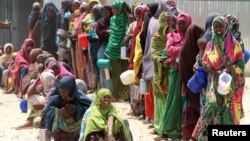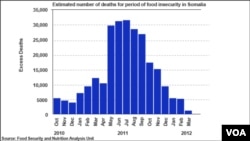NAIROBI —
A new study commissioned by the United Nations estimates 258,000 people died in Somalia as a result of food insecurity during a period of famine.
The joint report from the U.N. Food and Agriculture Organization and the U.S.-funded Famine Early Warning Systems Network outlines the grim statistics from a period of food insecurity from October 2010 to April of last year.
According to the study, 133,000 children under the age of five died as a direct result of a lack of food, or because they were made too weak to fight off disease.
In the Lower Shabelle region of southern Somalia, at the heart of the famine, an estimated 18 percent of the child population died.
At the height of the emergency, 30,000 people were dying each month.
U.N. Humanitarian Coordinator for Somalia Philippe Lazzarini, speaking to reporters from Mogadishu Thursday, called the figures “shocking” and said more could have been done to prevent the worst of it.
"After the famine was declared over in February 2012, the humanitarian community took a hard look at the events, we learned lessons, also we warned repeatedly from August 2010 that the food crisis was deepening, the aid operation and funding response was too slow," he explained.
The famine, declared in July 2011, was the result of two successive failed rainy seasons, resulting in poor harvests and the death of livestock.
The hardest-hit areas, in southern and central Somalia, were also under the control of the al-Shabab militant group, which had banned access to humanitarian agencies, making the crisis worse.
Lazzarini said after the famine declaration, humanitarian agencies were able to mobilize into previously inaccessible places.
He said the current aid and development strategy should focus on building the long-term resilience of Somali communities, so they can better withstand future shocks.
"We need to proactively invest in Somali people and communities now, to break the cycle of crisis and response," said Lazzarini.
The U.N. says about 2.7 million people are still in need of assistance in Somalia.
Al-Shabab continues to hold a grip on rural areas of southern and central Somalia, though they have been driven out of the major cities.
The new government of Somalia, formed last year after two decades of civil war, struggles to provide services in areas outside of the capital.
The joint report from the U.N. Food and Agriculture Organization and the U.S.-funded Famine Early Warning Systems Network outlines the grim statistics from a period of food insecurity from October 2010 to April of last year.
According to the study, 133,000 children under the age of five died as a direct result of a lack of food, or because they were made too weak to fight off disease.
In the Lower Shabelle region of southern Somalia, at the heart of the famine, an estimated 18 percent of the child population died.
At the height of the emergency, 30,000 people were dying each month.
U.N. Humanitarian Coordinator for Somalia Philippe Lazzarini, speaking to reporters from Mogadishu Thursday, called the figures “shocking” and said more could have been done to prevent the worst of it.
"After the famine was declared over in February 2012, the humanitarian community took a hard look at the events, we learned lessons, also we warned repeatedly from August 2010 that the food crisis was deepening, the aid operation and funding response was too slow," he explained.
The famine, declared in July 2011, was the result of two successive failed rainy seasons, resulting in poor harvests and the death of livestock.
The hardest-hit areas, in southern and central Somalia, were also under the control of the al-Shabab militant group, which had banned access to humanitarian agencies, making the crisis worse.
Lazzarini said after the famine declaration, humanitarian agencies were able to mobilize into previously inaccessible places.
He said the current aid and development strategy should focus on building the long-term resilience of Somali communities, so they can better withstand future shocks.
"We need to proactively invest in Somali people and communities now, to break the cycle of crisis and response," said Lazzarini.
The U.N. says about 2.7 million people are still in need of assistance in Somalia.
Al-Shabab continues to hold a grip on rural areas of southern and central Somalia, though they have been driven out of the major cities.
The new government of Somalia, formed last year after two decades of civil war, struggles to provide services in areas outside of the capital.









